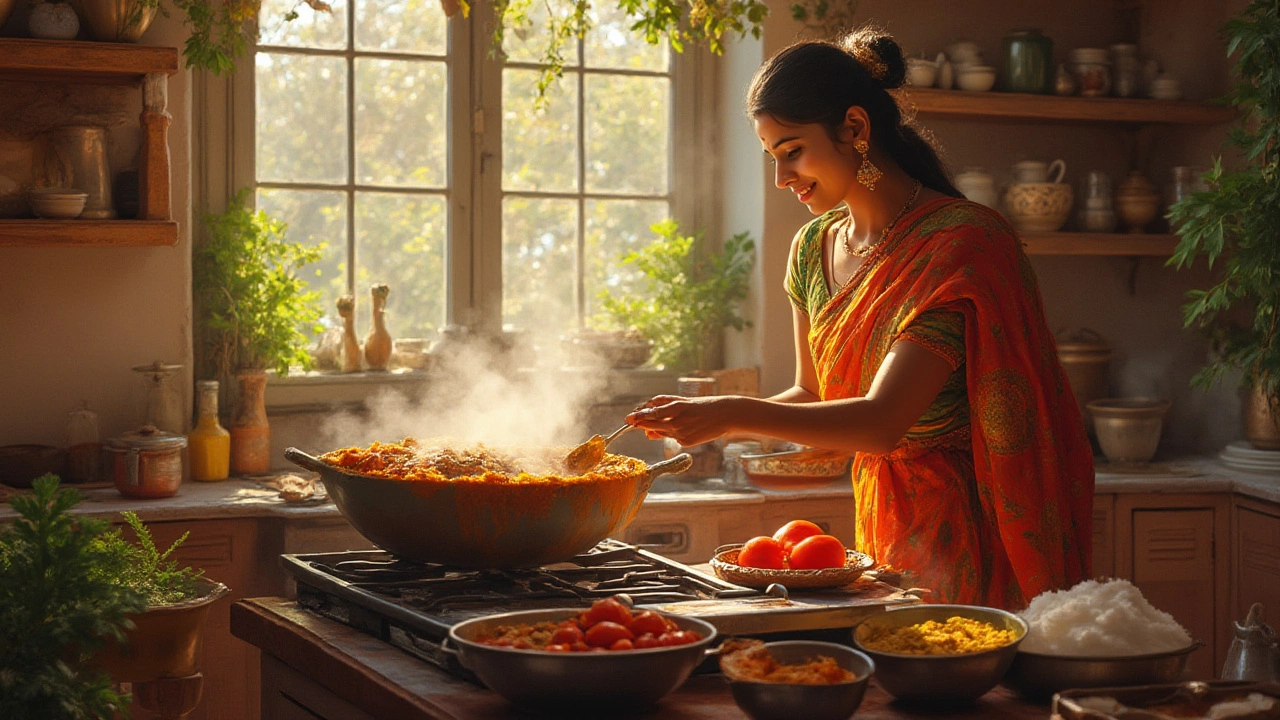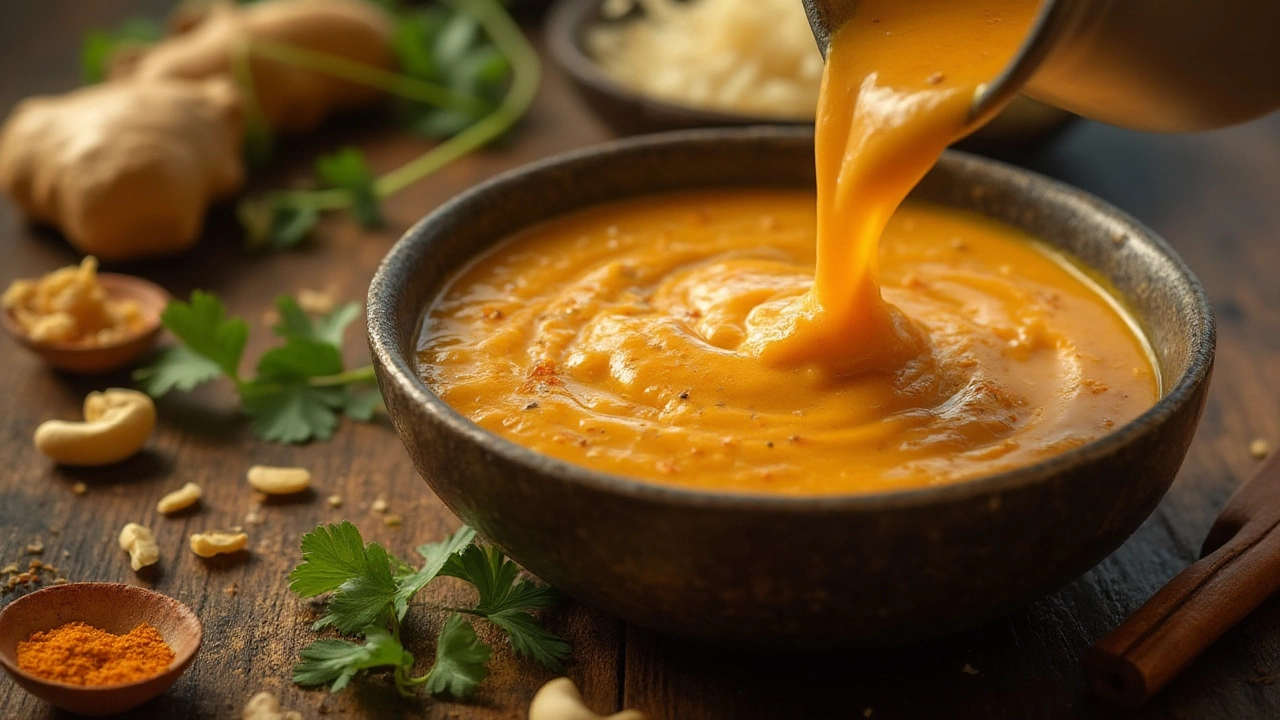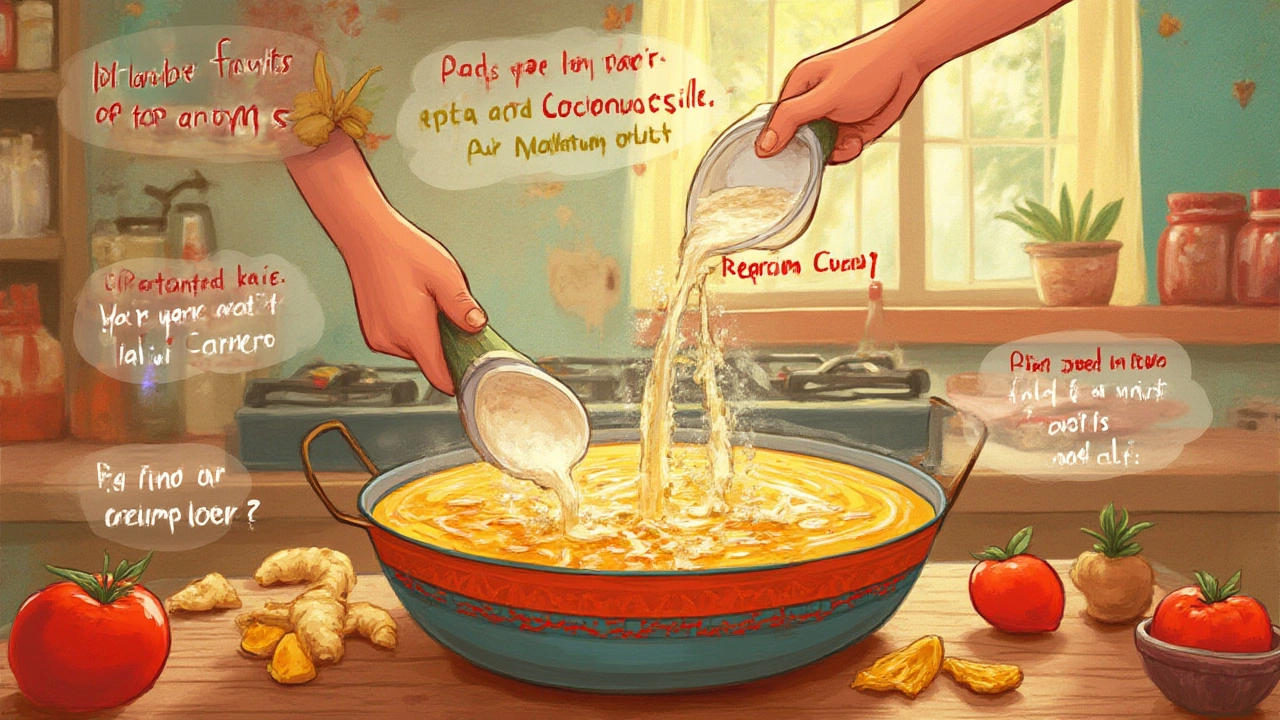What Makes Curry So Creamy? Secrets to Creamy Indian-Style Curries
 Jul, 18 2025
Jul, 18 2025
You’re at the table, hunched over a steaming plate of curry, and that first bite sends waves of flavor and comfort right through you. But it’s not just the spices or the heat—it’s the way the sauce hugs every piece, velvet-smooth, rich, and almost impossible to forget. That’s the magic of a creamy curry. What the heck is going on in that pot, turning simple ingredients into a sauce that nuzzles your taste buds and leaves you reaching for naan to soak up every drop? If you’ve ever tried making curry at home, you’ve probably noticed some turn out watery, and others, almost sinfully silky. Let’s unpack what really makes a curry so creamy and how you can get that restaurant-like lusciousness in your own kitchen.
The Real Creamy Curry Heroes: Ingredients That Matter
The road to creaminess starts with what you put in the pot. It’s not one miracle ingredient—it’s a mix of clever choices. Coconut milk is the most obvious, especially in Thai and South Indian curries. It’s rich in fat (about 17-24% in canned varieties), making it unbeatable for that smooth texture. But the Indian kitchen has plenty of tricks too: heavy cream (malai), whole milk, cashew paste, or even ground almonds. Not everyone knows this, but ground white poppy seeds and melon seeds are other Indian favorites for thickening and creamy depth, especially in Mughlai-style dishes.
This isn’t just about taste—it’s science. Fat molecules in coconut milk, cream, or blended nuts suspend the spices, smooth out acidity, and prevent things from splitting at high heat. Ghee or butter often sneaks in, especially at the end, to add gloss and a little extra richness. Ever noticed the luxurious, slightly sweet flavor in butter chicken? That’s a mix of tomato butter sauce plus cream poured in right before serving. Some curries, like korma, rely entirely on nut pastes (soaked and blended cashews or almonds), making them creamy without dairy.
You can skip the animal products entirely. Vegan dishes often use coconut, blended tofu, or soaked cashew paste for a similar effect. Just a heads-up: Low-fat coconut milk or “lite” cream won’t cut it—they lack the fat needed for that mouth-coating feel. If you have a nut allergy, sunflower seed or pumpkin seed pastes can work in a pinch. North Indian gravies sometimes rely on yogurt, but you’ll want to whisk it well and add slowly on low heat to avoid curdling.
Cooking Techniques: How Method Makes Creamy Magic
Technique matters as much as what goes in. A big mistake at home is dumping everything into the pot all at once and cranking up the heat. Getting that silky texture means building your base: Fry your aromatics (onion, garlic, ginger) on a medium flame until deep golden brown. That slow caramelization pulls out their natural sugars and softens the texture, which helps with creaminess. After that, spices go in for a quick roast—just 30 seconds or so—before any liquid joins the party, unleashing their oils and deep flavors into the fat.
The sauce gets smoother the more you blend. Traditional chefs will use a hand blender right in the pot or pour the fried onion-tomato base into a high-powered mixer, then return it to the pan. This breaks everything into microscopic bits, so you get that velvety finish rather than a chunky mess. Pureeing is what gives restaurant curries their almost unreal smoothness.
Adding cream or coconut milk needs care—never at a rolling boil. Heat can cause dairy to split or coconut milk to curdle, so always stir it in on low heat, right at the end. Ever noticed the swirl of cream on dal makhani or tikka masala? That’s not just for Instagram. It’s a chef’s trick to get the creamiest finish right before serving. Don’t be afraid to finish curries with a knob of cold butter (off-heat), which makes the sauce shinier and rounder.
If you’re blending nuts or seeds, soak them an hour or two beforehand—they’ll grind smoother. For a richer flavor, lightly toast nuts before soaking. If you want the curry even thicker, let it simmer uncovered until some water evaporates, always stirring to prevent sticking. Some grandmothers swear by stirring constantly with a wooden spoon for half an hour—not the fastest approach, but unbeatable for dense, creamy curry.

Why Some Curries Aren’t Creamy (and How to Fix Them)
Ever wondered why some home-cooked curries never get that restaurant-style lushness? The first culprit is too much liquid (often added out of fear things will burn). Second, skipping the blending step turns bases lumpy rather than smooth. And plenty of home cooks forget the fat—it’s tempting to go healthy but truly creamy curry needs a bit of indulgence.
If your curry is thinning out, here’s what you can do. Try reducing it over low heat, stirring often. Add a spoonful of cream, cashew paste, or coconut cream at the end—this won’t fix every curry, but it’ll help. For curries with a tomato base, don’t skip sugar; just a pinch balances out acidity, letting richness shine. A lot of Asian chefs secretly add a teaspoon or two of powdered milk, blending it in for extra body (especially in restaurant butter chicken or paneer makhani).
Another reason could be overcooking dairy. Add yogurt or cream too early or at high heat, and they’ll split, getting gritty instead of smooth. Tame the heat before adding anything milky, and keep the pan moving. One pro hack: Make a paste of flour and water (about a teaspoon of each), stir it into the hot sauce, and let it simmer—this gently thickens without changing the flavor or causing lumps.
Regional Styles: How Different Places Cream Their Curry
Not all curries go creamy the same way. Walk through South India, and you’ll smell coconut milk simmering with curry leaves, whole spices, and tamarind. Kerala-style fish curries, for example, often use pure coconut cream—scooped from the top of the can—for unbeatable silkiness. In Goa, cashew nuts go into the mortar and pestle, creating a paste that thickens prawn curry like nothing else.
Travel north and you’ll find Mughlai dishes—think korma, pasanda, shahi paneer—where cream and ground nuts form the backbone. Butter chicken (murgh makhani), invented in Delhi in the 1950s by the creators of the first tandoori chicken, is a classic: tomato, butter, cream, all blended into a sauce so smooth it sticks to your spoon. Kashmir takes a different route, using yogurt and poppy seeds for lamb rogan josh or dum aloo, balancing heat and coolness in a single bite.
Thai curries, meanwhile, ramp up coconut—but with a twist. Aromatic pastes made from shallot, lemongrass, and galangal go straight into bubbling coconut milk, making the curry paste “bloom” and give off extra flavor oils. Indonesian and Malaysian curries favor coconut too, but often add toasted coconut (kerisik) to add thick, nutty undertones. Even Japanese curry, famous for being thick and mild, gets its texture from a wheat flour roux and sometimes a splash of cream at the end.
No single way rules them all—each region adapts according to what grows locally, whether nuts, coconuts, or pasture milk. The key ingredient? A clever balance of fat, gentle technique, and just the right amount of pureeing for the desired texture.

DIY Creamy Curry: Tips and Tricks for Home Cooks
Ready to try making creamy curry at home? Here’s what actually works—not the shortcuts, not the myths. Start with good fat: coconut milk (full-fat, never skim), heavy cream, or a homemade nut/seed paste. For nut pastes, soak cashews or almonds for 1-2 hours, blend until silky with a splash of water, then add after frying your aromatics. Don’t skip the caramelization step—let onions go golden before adding tomatoes.
Always blend the base before adding meat or veggies for that dreamy texture. Add your creamy curry component (cream, coconut, or blended nuts) at the very end, off the heat if you can. Ghee, butter, or coconut oil each add extra shine and flavor—that final swirl makes all the difference. If you want variations, you can mix nut pastes with coconut milk for extra richness, or even add a spoon of plain yogurt for tang along with creaminess, just whisk well to keep things smooth.
Watch your heat. Dairy and coconut milk both hate boiling; low, gentle simmering is your friend. If you’re using yogurt, temper it: whisk very smooth, then mix in a little hot sauce to keep it from curdling. For restaurant-style thickness, try adding a tablespoon of tomato paste and a pinch of sugar to round things out, then finish with a drizzle of cream or a swirl of cold butter right before eating.
Want a thicker sauce? Reduce the curry on low, uncovered, and stir constantly to keep it smooth. If you’re feeling adventurous, try toasted melon or poppy seeds for a Mughlai spin—they add subtle richness. Fresh herbs, like cilantro, brighten the finish, but add these right before serving to avoid dulling the flavor.
And the final tip: Don’t be afraid to layer textures. A curry can be creamy and still pack a punch with toasted spices, crunchy nuts, or crisp fried onions on top. Play with the formula until it’s just how you like it. Your kitchen, your call!